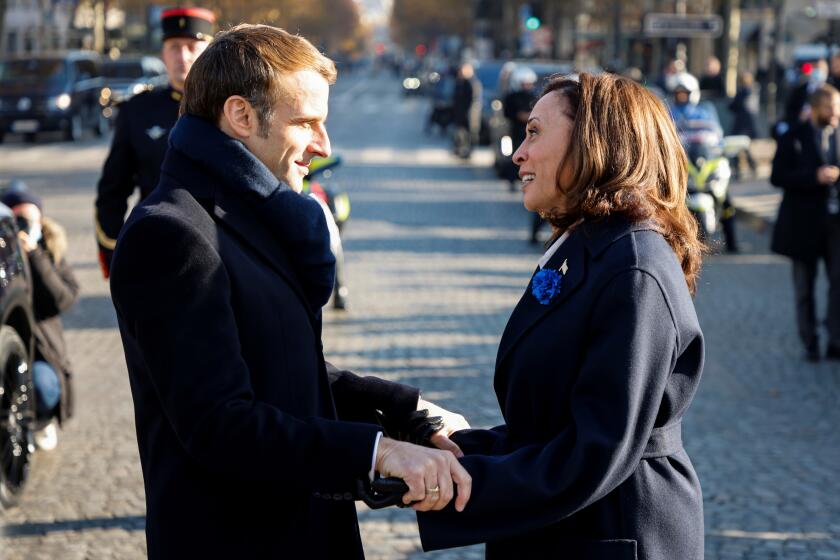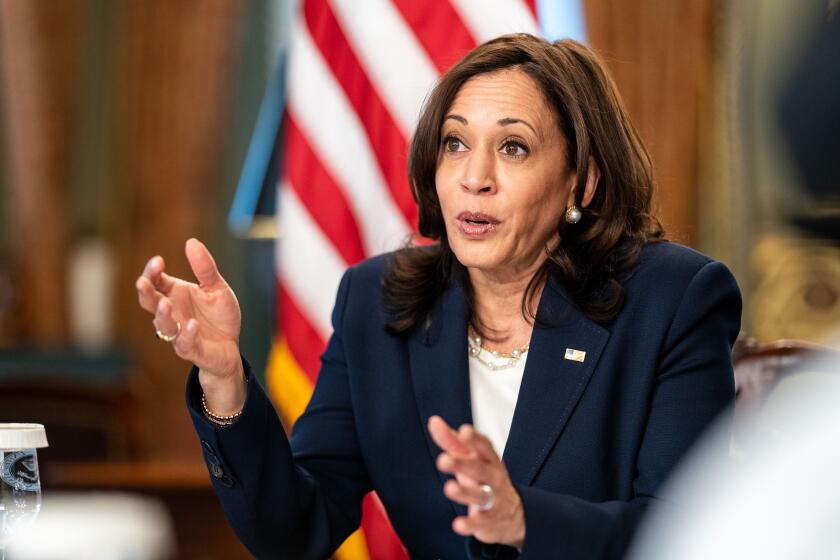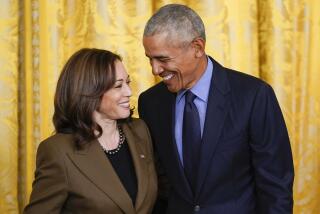Column: Kamala Harris, the incredible disappearing vice president

WASHINGTON — Whatever happened to Kamala Harris?
She shattered all kinds of ceiling glass when Joe Biden made California’s junior senator his running mate and Harris was elected vice president. Since then, she’s largely receded from Washington’s daily doings and the cliff-hanging drama that’s surrounded the fight over the president’s agenda.
Part of the answer is simple: What happened to Harris is she became vice president.
Even as she shoulders an array of policy portfolios, even as she visits Paris this week seeking to address the administration’s ruptured relations with France, it remains a fact that the No. 2 job in the White House is inherently a diminishing one.
It’s neither racist nor misogynistic to point that out when the jobholder happens to be Harris.
Virtually every vice president in modern history — save Dick Cheney, who played an unusually prominent role guiding defense and foreign policy under President George W. Bush — has looked smaller than when he or she accepted the position.
That’s because a main job requirement is stepping away from the spotlight, except when cheerleading for the president and his agenda.
This requires varying degrees of sycophancy. After four years of emasculation, Mike Pence didn’t seem to mind that his boss, President Trump, wasn’t at all upset that some of Trump’s supporters wished to kill Pence for refusing to illegally overturn Biden’s election. Pence, whatever else he accomplishes in life, has managed to set new standards for tolerance and self-abasement.
Vice President Kamala Harris, in trip to France after months of getting battered at home, is introducing herself in personal terms on the world stage.
There were different, heightened expectations for Harris, chiefly because of her groundbreaking election. No one like her — the first woman, first Black person, first Asian American elected vice president — has ever moved through Washington’s uppermost reaches. Her every action would be unprecedented and surely, it seemed, merit special notice and great amounts of news coverage.
But that one cardinal rule — to never purposely overshadow the president, or seem eager to take his place — doesn’t yield to history or celebrity. That’s especially true when the chief executive is a brittle 78-year-old.
So ever since taking office, Harris has made humility a top item on her public-facing agenda, alongside the assignments — voting rights, space exploration, women in the workforce, immigration from Central America, and more — the president has given her. It’s no surprise. Caution has long been a hallmark of Harris’ political career, and the subservient nature of the vice presidency, as well as the scrutiny of Biden loyalists sensitive to the merest hint of personal ambition, reinforce that inclination.
(There is a long history of tensions between presidential and vice presidential staff members, and the Biden White House is no exception.)
Another reason for Harris’ fade to the background is her thin Washington resume.
Typically, vice presidents are chosen because they are perceived as “doing something the president can’t do, or can’t do very well,” said Chris Devine, who teaches political science at the University of Dayton and has co-written two books on the vice presidency.
Biden, Cheney and Al Gore had the Capitol Hill experience that the presidents they served under — Barack Obama, Bush, Bill Clinton — lacked. Pence, a congressman for more than a decade before becoming Indiana’s governor, served as Trump’s emissary to the conservative and evangelical wings of the GOP.
There’s not a whole lot Harris can do that Biden cannot, or hasn’t done already — including acting in the job she now holds.
The president served 36 years in the Senate and Harris just four — much of which she spent preparing for a 2020 run for president — so it’s not as though Biden needs Harris’ help forging relationships with lawmakers or finding his way up Pennsylvania Avenue to the House and Senate. Although the vice president was among those making phone calls last week from the war room established to push Biden’s big infrastructure bill past the finish line, she hasn’t played the role of legislative closer that Biden did under Obama.
Harris, 57, is on her third foreign trip as vice president. Biden began traveling overseas as a senator when Harris was still in grade school. So it’s not as though Biden has to look to his vice president to explain the difference between the World Bank and International Monetary Fund, or to teach him the protocol for meeting the Pope, whom Biden has visited with three times.
Candidates can’t get a grip on President Biden. So they’re going after his No. 2.
Harris was chosen to run alongside Biden in great part because she brought balance — relative youth, her race and gender — to the Democratic presidential ticket. In the White House, the president has strived to make his vice president appear to be a full partner in the “Biden-Harris administration.” In practice, though, she’s more like an apprentice.
There are several vice presidents who stepped out from the shadow of the Oval Office and the self-effacing No. 2 job to win the presidency, including after serving under larger-than-life figures like Ronald Reagan or history-making ones like Obama.
Barring unforeseen events, Harris has at least three more years, and possibly as many as seven, to learn and grow in the White House.
She’ll mostly do so out of sight and, for many, out of mind.
More to Read
Get the latest from Mark Z. Barabak
Focusing on politics out West, from the Golden Gate to the U.S. Capitol.
You may occasionally receive promotional content from the Los Angeles Times.













